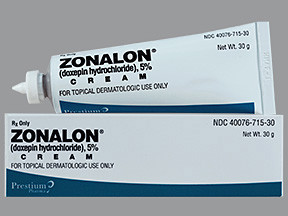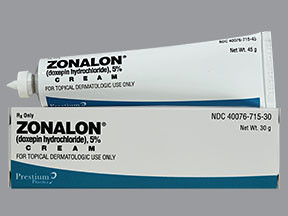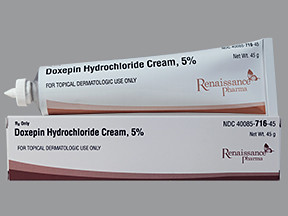DOXEPIN CREAM - TOPICAL
PHONETIC PRONUNCIATION: (dox-EH-pin)
COMMON BRAND NAME(S): Zonalon
GENERIC NAME(S): doxepin HCl
Uses
USES: This medication is used to relieve troublesome itching from certain skin conditions (e.g., atopic dermatitis, eczema, neurodermatitis). It should be used only for a short time (no more than 8 days). Doxepin is a tricyclic antidepressant. It is not known how this medication decreases itching. Some medication is absorbed into the body when the cream is applied. This medication may work by blocking a certain natural substance (histamine) that your body makes during an allergic reaction. The decrease in itching may be a result of drowsiness or some other effect in the brain that causes you not to notice or be bothered by the itching.
How to use DOXEPIN CREAM - TOPICAL
HOW TO USE: Before applying the medication, clean the affected area with mild soap and water, rinse well, and pat dry. Gently rub a small amount of the medication into the affected area in a thin layer, usually 4 times a day. Wait at least 3-4 hours between applications, or use as directed by your doctor. How often the medication is applied and for how long depends on your condition and response to treatment. Usually, this medication is for short-term use only (up to 8 days). Wash hands immediately after use unless the area being treated includes the hands. This medication is for use on the skin only. Avoid getting the product in your eyes, nose, ears, mouth, or vaginal/anal area. If the medication gets in these areas, rinse immediately with clean water. Do not cover the area with plastic or waterproof bandages. Covering the treated area may increase the absorption of the medication through the skin and increase the risk of side effects. Do not use more of this product, use it more often, or keep using it longer than prescribed by your doctor. Your condition will not improve faster and the risk for side effects will increase. Side effects may increase when you use the cream on a larger area of skin (e.g., more than 10 percent of your body surface). Tell your doctor if you have severe drowsiness while using this product. It may be a sign that you are absorbing too much of the medication. Your doctor may tell you to decrease how often you apply the medication, the amount of medication used, or how much skin to spread the medication over. Follow your doctor's directions carefully. Tell your doctor if your condition does not improve or if it worsens.
Side Effects
Precautions
Interactions
Overdose
Images
Reviews
Faq for DOXEPIN CREAM - TOPICAL
Doxepin cream is a topical medication that contains the active ingredient doxepin, a tricyclic antidepressant. It is usually used to treat pruritus (itching) associated with certain skin conditions.
Doxepin cream works by blocking the histamine receptors in the skin, reducing itching and inflammation. It also has mild sedative properties that can help relieve discomfort and promote better sleep.
Doxepin cream is commonly used to treat itching associated with atopic dermatitis (eczema), prurigo nodularis, lichen simplex chronicus, and other skin rashes or irritations.
Apply a thin layer of Doxepin cream to the affected skin area and gently rub it in until absorbed. It is usually advised to apply it 4 times a day, with at least 3-4 hours between applications. Wash hands after each application.
Common side effects of Doxepin cream may include burning, stinging, or itching at the application site. Rarely, it may cause drowsiness, headache, or mild skin irritation. Seek medical attention if you experience severe allergic reactions or worsening of symptoms.
The use of Doxepin cream during pregnancy or breastfeeding should be discussed with a healthcare provider. While systemic absorption is minimal, it is still recommended to consult a doctor to evaluate the potential risks and benefits.
Doxepin cream is generally considered safe for children aged 12 and above, but it should be used under the guidance of a healthcare professional. The dosage and frequency may vary based on the child's age and condition.
It is generally safe to use moisturizers or other topical medications alongside Doxepin cream. However, it is recommended to wait for at least 1 hour after applying Doxepin cream before applying any other products to the same area.
The effectiveness of Doxepin cream varies among individuals and the severity of the condition. It may provide relief within a few days of regular use, but it can take several weeks to see maximum improvement in symptoms.
Disclaimer
IMPORTANT: HOW TO USE THIS INFORMATION: This is a summary and does NOT have all possible information about this product. This information does not assure that this product is safe, effective, or appropriate for you. This information is not individual medical advice and does not substitute for the advice of your health care professional. Always ask your health care professional for complete information about this product and your specific health needs.



No Reviews Yet